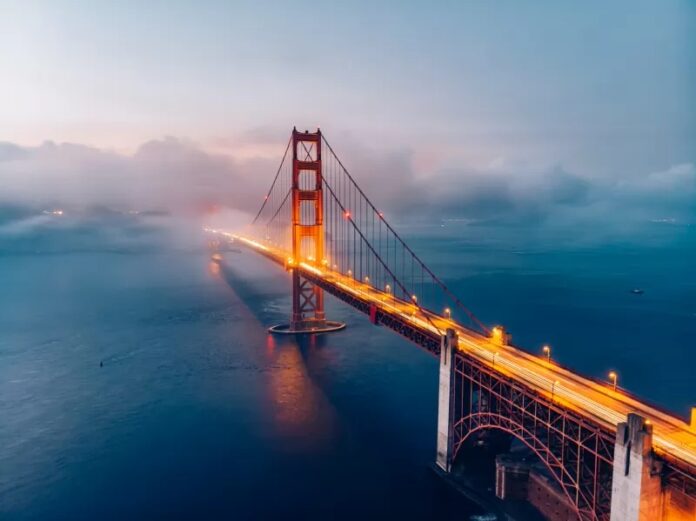The beautiful Golden Gate Bridge is one of San Francisco’s most famous (and Instagram-able) locations. With visitors flocking to walk across the nearly 9,000-foot suspension bridge, it’s certain to say that this bridge was a major engineering feat of its time.
Brief History of the Golden Gate Bridge
During the challenging times of the Great Depression, bridge engineering firms from throughout the US put forth 11 final proposals by 1930. Chief Engineer Joseph B. Strauss’ winning design was seen as a beautifully refined version of what was originally described as “an upside-down rat trap” in the 1921 submission.
The funding for the future bridge mostly came from a local bond issue that got resounding approval through a popular vote. There were parades, fireworks, and festivities celebrating the occasion. Even local citizens in six counties embraced the $35 million construction project. They demonstrated their unwavering support by agreeing to use their homes, farms, and businesses as collateral, showing their strong commitment to this collective endeavor.
Need to Know
On the memorable day of May 27, 1937, about 200,000 individuals paid a quarter each for the privilege of walking across the bridge. The very next day, President Franklin D. Roosevelt announced that the bridge was approved for vehicular traffic.
With a simple yet significant telegraph key signal from the White House, a new era of accessibility and connection was officially ushered in.
Here are a few more interesting reasons why the Golden Gate bride is important to US history.
1. It’s the Longest Suspension Bridge
During its construction in the mid-1930s, the Golden Gate Bridge spanned an impressive 1.7 miles, proudly claiming the title of the world’s longest suspension bridge at that time. This remarkable record stood strong for nearly a quarter of a century, until New York’s Verrazano Narrows Bridge was built in 1964.
However, this iconic landmark of San Francisco still holds its position as the second-longest suspension bridge in the entire country. It stands as a testament to the unwavering human spirit and boundless creativity that brought such an extraordinary vision to life.
Fast Fact
The bridge is built entirely of American-made steel from plants in Pennsylvania, New Jersey, and Maryland; this steel was carried by ship through the Panama Canal.
2. It Represents a Seemingly Impossible Feat
The Golden Gate Bridge was nicknamed “the bridge that couldn’t be built” because it seemed impossible to build. The water beneath the bridge flows with strong tides and currents in water over 300 feet deep in its center. The strong winds and thick fog only made things more difficult.
Despite the drawbacks, engineer Joseph Strauss was named to lead the project. Construction began in late 1932 and, by its completion in May 1937, costs tallied $35 million. According to the CNN Library, the stunning Art Deco-style bridge was completed ahead of schedule at $1.3 million under budget.
Some experts believe that the construction of the bridge, which would cost $1.5 billion in today’s dollars, may not even be possible today.
3. The Process Involved Unprecedented Safety Measures
The construction of the Golden Gate Bridge resulted in the unfortunate loss of 11 lives, a remarkable achievement in terms of safety for the time. An inventive measure was taken to enhance safety by installing a massive safety net beneath the bridge to prevent accidents from slipping or falling.
However, a construction incident led to 10 out of the 11 fatalities when a work platform unexpectedly gave way and plunged through the safety net. On a positive note, this safety net successfully saved the lives of 19 individuals, who were subsequently honored as part of the “Halfway to Hell Club.”
In the spirit of safety first, Strauss insisted that bridge workers wore construction hard hats, modified from a design used by miners. Other safety innovations included non-glare goggles, sun and wind protection cream, a sandblast respirator, and even a special diet to combat dizziness.
4. The Signature Orange Color Was a First
Whether covered by fog or standing out against bright blue sky above and water below, the bridge’s signature color was actually an accident. The reddish-orange was only meant as a primer coat. The original traditional choices for large bridges were grey, black, or silver.
When consultant architect Irving Morrow received letters of support from residents, a vermilion to match the primer won out as the color of choice, now known as International Orange.
Fast Fact
This majestic landmark painted in signature International Orange is thought to be the most photographed bridge in the world.
5. It Built a Gateway to Northern California
Before the Golden Gate Bridge and the San Francisco-Oakland Bay Bridge opened to automobile traffic in 1937, the only direct transportation from San Francisco to Marin County was by ferry. The Golden Gate Bridge represented the dawn of a new era for Bay Area residents, making it much easier to travel north up the coast from San Francisco.
6. It Was Inspired by the Golden Gate
In Portugal’s capital city, the Ponte 25 de Abril suspension bridge completed in 1966 is Lisbon’s striking lookalike of the Golden Gate Bridge, right down to its color. The Lions Gate Bridge, a suspension bridge visible from downtown Vancouver in British Columbia, also has a strong resemblance to the iconic Golden Gate as well.


